Lucio Fulci should be a recognized name if you enjoy gore-fests in horror films. He is widely referred to as the “Italian Godfather of Gore,” and rightfully so! This Italian director has worked in a variety of genres, but horror appears to be his strongest suit. He became a horror movie legend after starring in ‘Zombie’ in 1979. His ‘Gates of Hell’ trilogy has been as controversial as it has been popular.
Despite the fact that the three films’ plots are utterly unconnected, they do share a common concept. All of these films have a portal into hell and a locale where residents are threatened by a supernatural threat. Oh, and there is one more thing they have in common: a lot of gore and graphic violence.
This is not a trilogy for the faint of heart. The story is full of terrible incidents, from insides being vomited to individuals being ripped apart. We will get up close and personal with all three films in this video, so the queasy should turn away now!
City of the Living Dead (1980)
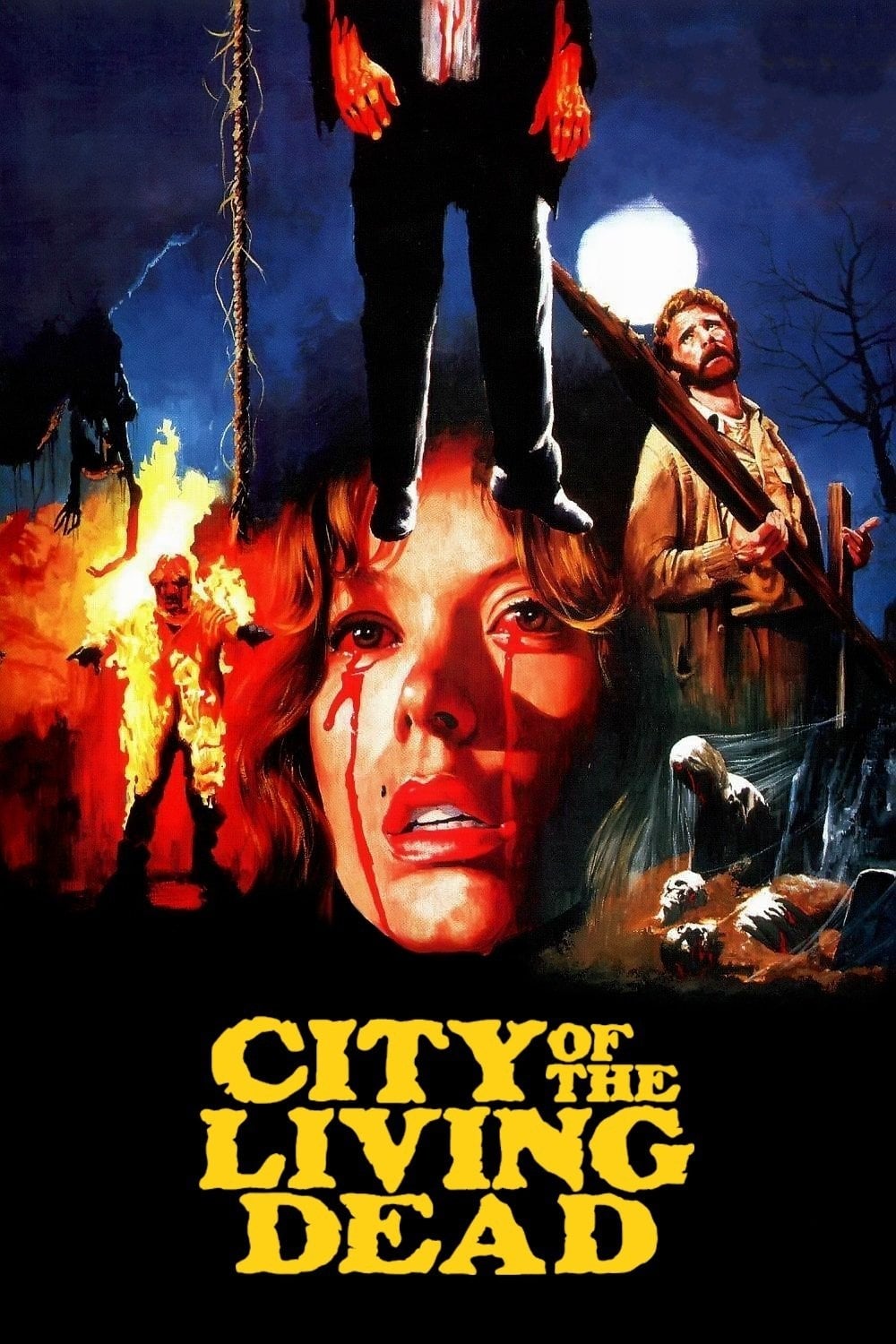
A séance is being held at Theresa’s apartment in New York City. Mary, one of the participants, has a troublesome vision, where she watches a priest named Father Thomas hanging himself in a cemetery of a remote village called Dunwich. Her vision is a bit too disturbing, and she collapses and goes into convulsions.
The police suspect some foul-play, and Sergeant Clay interrogates Theresa regarding the matter. She warns him maniacally about an imminent evil. The entire episode catches the interest of a reporter named Peter Bell. Mary is presumed dead and buried in a local cemetery, where the journalist follows. Luckily for Mary, he hears her muffled screams and breaks her out of the casket. It turns out that she regained consciousness after being buried!
Peter and Mary meet Theresa, who reveals more about the imminent evil. According to an ancient book, Mary witnessed the event that would bring the dead into the world of the living. The death of the priest had opened up a portal through which the invasion would begin on All Saints Day, which was only a few days away!
Back in Dunwich, some strange and unexplained events are bothering the residents. Bob, a troubled young boy, experiences some disturbing sights of rotting carcasses in an abandoned house. An apparition of Father Thomas slaughters a young lady, and everyone suspects Bob to be behind the murder. A local psychiatrist, Gary, and his patient Sandra witnessed some paranormal activities at her place.
Meanwhile, Bob ends up in Mr. Ross’s garage, and his teenage daughter offers him marijuana. Mr. Ross thinks Bob is trying to seduce his daughter and impales him on a drilling lathe. The next morning, Mary and Peter arrive at the graveyard that Mary saw in her vision. They meet Gary and Sandra, and just as they try to discuss the mysterious events, maggots rain on them in a supernatural attack.
They soon learn that the young lady who was killed by Father Thomas came back and killed her parents. As they rush to help her brother, John-John, Sandra’s scalp is ripped off by the young lady who is back from the dead. As more killings follow, a state of emergency is declared in the locality. Mary, Gary, and Peter head to the cemetery and find a maze of skeletal remains and other mysterious things in the tomb.
Suddenly, Sandra is back as a zombie, and she kills Peter. Gary quickly impales her with a wooden spike, but All Saints Day has already begun. The dead are being led by Father Thomas. Just as he tries to hurt Mary, Gary uses a wooden cross to disembowel him.
He bursts into flames along with the other corpses, and Mary and Gary escape from the tomb. It seems like the gates of hell have been closed. They soon spot John-John running towards them, and they are happy to have survived the cursed event. However, the movie ends on a cliffhanger as the joyous smiles are soon replaced by Mary’s blood-curdling scream as John-John approaches them!
The Marvelous Verdict
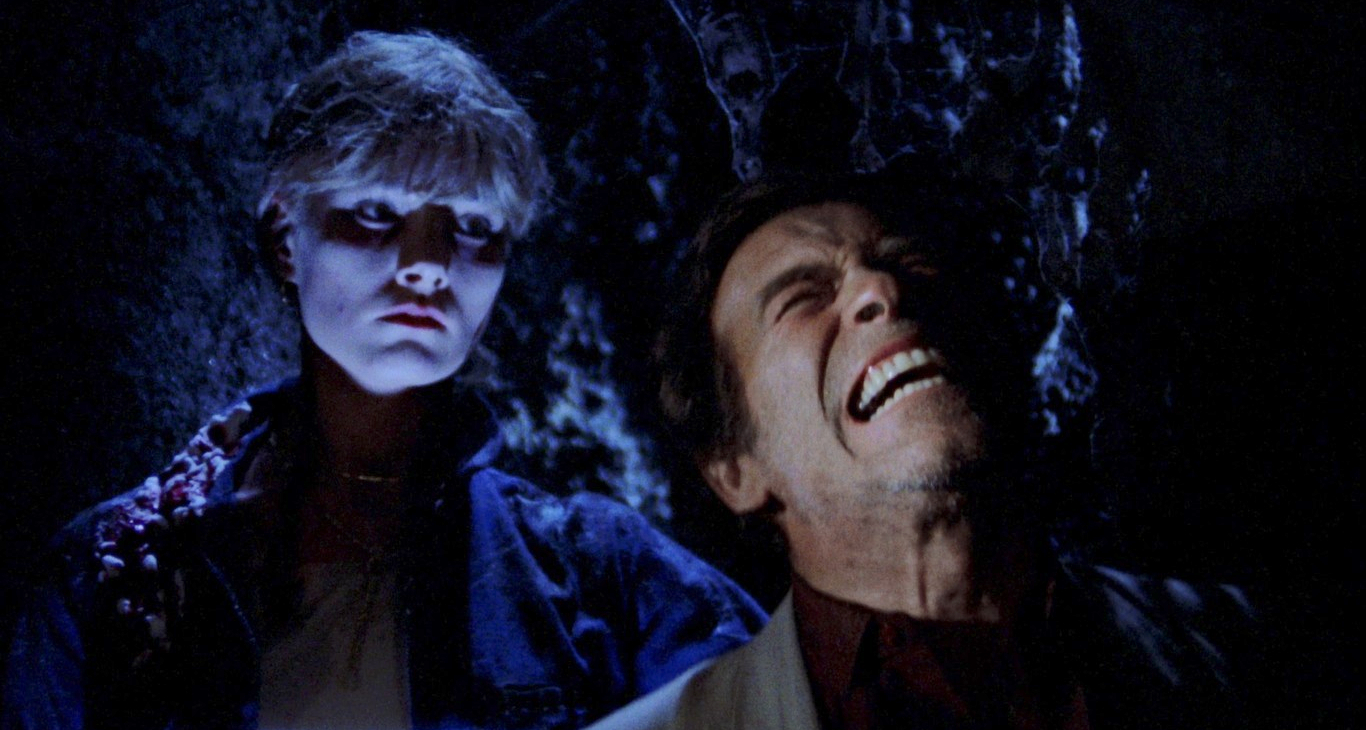
The late horror maestro, Lucio Fulci, is an absolute artist when it comes to splatter horror! This movie is exactly in his comfort zone. A story of the dead coming back to life is just the kind you would expect from him! The story itself is not the strongest asset of this movie, but the atmosphere and imaginative narrative lets you look past the flaws.
The director was inspired by H.P. Lovecraft, and the location of Dunwich will surely ring a bell for those familiar with Lovecraft’s work. The gore effects by Gino de Rossi are out-of-the-world; right from the squished brains to maggots and rotting flesh, everything looks disturbingly real. There are some gruesome deaths, such as the one with an electric drill through the head and another instance where a woman vomits her internal organs!
The narrative is full of shocks and thrills, and blood and guts flow regularly. The acting struggles a bit, except for the lead actor Christopher George who delivers a spirited performance. Overall, this was quite a rollicking start for the Gates of Hell trilogy. This film is rightly regarded as a first-class gore-fest from the Italian horror icon!
The Beyond (aka Seven Doors of Death) (1981)

The movie begins in 1927, and we see an artist named Schweick at work. He is fashioning a hellish painting in Room 36 of the Seven Doors Hotel. Suddenly, a mob drags him outside and kills him, accusing him of practicing black magic. All this while, a strange white-eyed woman reads an ancient tome and prophesies the opening of one of the Gates of Hell.
The narrative moves ahead several years and we are now in 1981. Liza has inherited the hotel, and she has moved in to prepare it for a grand reopening. However, this cursed place still bears the scars of its horrifying past. One of the workers glimpses upon the white-eyed woman, and he falls from his scaffolding.
A local doctor named John takes him to the hospital. Meanwhile, Liza is surprised by a bell from Room 36, because the hotel had not opened yet and the rooms were not occupied! There is a problem with the running water in the hotel and Joe, a plumber is sent to look into it. He heads to the basement and unfortunately uncovers an area that was bricked off.
Joe is attacked by a ghoul-like entity and the hotel maid Martha soon finds the bodies of Joe and Schweick. They are dispatched to the hospital morgue, but the casualties in the hotel have only just begun! Liza meets a blind woman, Emily, and she warns Liza about the hotel. Even John, the doctor, tells her not to go ahead with the hotel project. However, for Liza, this was a golden opportunity that she simply couldn’t let slip.
Emily even meets her at the hotel and tells her to never step into Room 36. She tells her the story of Schweick, and while examining his painting Emily’s hands start to bleed without any reason. She leaves the hotel in a hurry along with her guide dog, and Liza is bewildered that their footsteps are not audible as they flee!
Even after all the warnings, like a true horror film, the character Liza steps into the room. She is shocked to find Schweick’s corpse pinned to the bathroom wall. But when she returns later with the doctor, the corpse is missing. The doctor also tells her that the town has no blind women, and the house where Emily supposedly lived had been empty for many years.
When the main architect of the hotel arrives, he discovers that the blueprint of the building has some unexplained space in the basement that is unusually large. The architect has immediately knocked off a ladder.
As he lies on the ground, he is attacked by a spider that eats him alive. The hotel maid is attacked and killed by the animated corpse of Joe. All this while, John goes to investigate the house where Emily supposedly lived. He comes across the ancient text that suggests that the hotel is one of the seven gates to hell.
Back at the hotel, Liza is attacked by another undead hotel worker, and she runs into John while trying to flee. They head to the hospital, where the situation is not any better and another doctor is brutally killed. John and Liza try escaping from the hospital down a staircase, but it leads them to the hotel basement.
They end up in the same wasteland that had been painted by Schweick. Dead bodies are scattered all around and the arid landscape is pure evil. There is nowhere to run and no matter where they go, they always end up at the same point. The film ends on this catastrophic note, and any hope of an escape is trashed when the protagonists are trapped in this arena for eternity.
The Marvelous Verdict
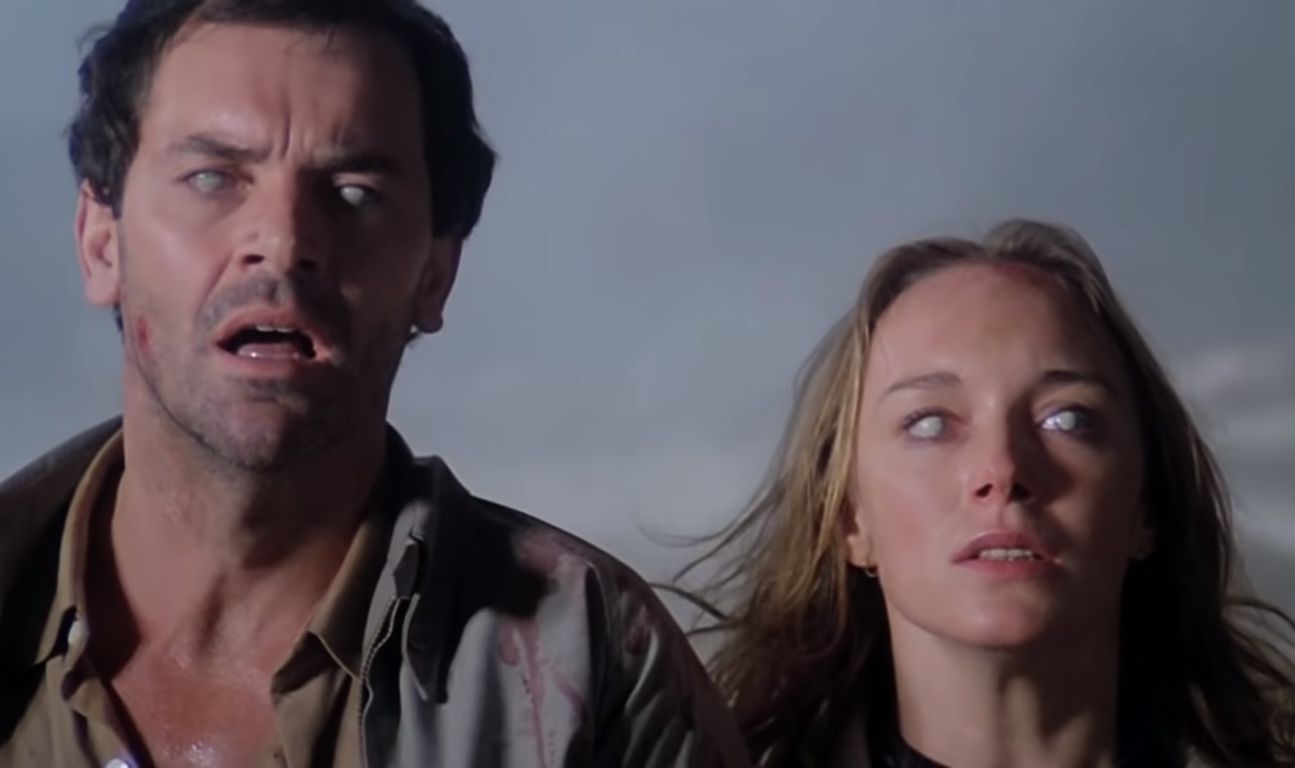
If the first movie in the Hell trilogy is sheer excitement and gore, this one definitely has more substance. It is another dive into the director’s wonderful horror segment with a dreadfully dreary narrative. The visuals are the strong point of this movie and you have to digest some morbid moments yet again. The gothic flavor of the film is unmistakable and the cinematography has a certain nightmarish flow. It not only makes the movie beautiful but also haunting in a way.
The musical score fits perfectly with the narrative and the special effects steal the show as is always the case with Lucio Fulci’s movies. The credit, once again, goes to the legendary Gino de Rossi, who probably did his best work while working with Fulci. The deaths are both unique and horrifying, and we love how the element of horror has been preserved right through the movie. If you expect the deaths to be gory, Fulci wouldn’t disappoint you one bit!
There is an eye-getting ripped out, a morbid crucifixion, spiders feasting on a man, and many more images to haunt you for days to come. Even the ending is as disturbing as the premise, and once you watch this classic you will understand why so many people regard this as a classic and one of Fulci’s best!
The House by the Cemetery (1981)
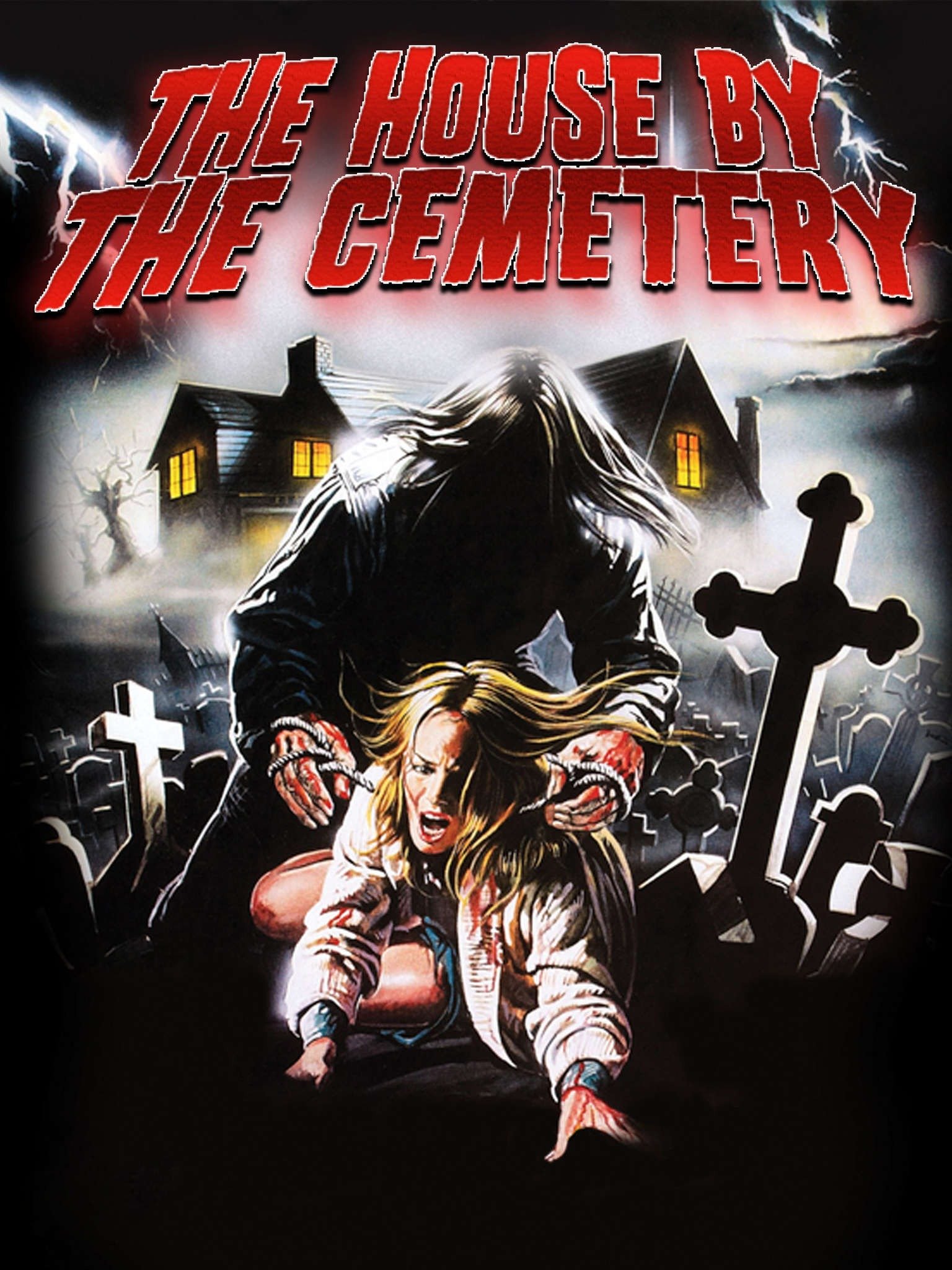
The movie opens on a terrifying note, as we see a young lady looking for her boyfriend in an abandoned house. He brought her there to fool around but is now nowhere to be seen. Suddenly, she spots his mutilated dead body and she gets stabbed and dragged away. We then see a family moving into the same house.
Bob, a young boy, and his parents Norman and Lucy have no clue about what they are walking into! The previous owner of the house was a colleague of Norman, but he had killed himself after murdering his mistress. Norman had been doing some research on old houses, and this place seemed to be a perfect spot for him. Little does he know what awaits him and his family!
Even before they moved in, Bob was warned by a young girl named Mae. She could be seen in one of the photographs of the house, but no one else could see her outside. She warns Bob to stay away from the house, but the young boy has little choice! The house is called Oak Mansion, and it is in desperate need of repairs. The family takes in a woman named Ann to be Bob’s babysitter.
As they settle in, they discover that one of the cellar doors is sealed and nailed shut. Ann unlocks it that night, and as you might have guessed already, she really shouldn’t have! Meanwhile, Bob is being shown around the place by Mae, and she takes him to a tombstone marked Mary Freudstein.
Apparently, she is not really buried there. Lucy comes across the tombstone of Jacob Tess Freudstein inside the Oak Mansion. When Norman is injured by a bat, the family gets genuinely spooked and they want to leave. However, the real-estate office suggests that they would have to stay put for a few more days. While they are at the hospital, one of the real-estate office agents comes visiting, and she is stabbed to death and dragged away.
Norman learns more about Freudstein, and it turns out that he was a Victorian surgeon who performed illegal experiments back in the day. He leaves for New York to read up more on this matter. Back in the house, Ann is attacked in the cellar when she goes looking for Bob. She is beheaded by Freudstein, leaving Bob horrified after witnessing the decapitation. His mother refuses to believe his account.
Later, Bob goes back to the cellar looking for Ann, and he gets locked inside. Lucy tries to reach him, but she fails to open the cellar door. Eventually, Norman hacks the door open, and for a brief moment, we see the maggot-infested rotting hand of Freudstein hacked off. Norman and Lucy find several bodies in the cellar.
It turns out that Freudstein was a living corpse. He continues his life by using the body parts of his victims to regenerate his blood cells. When Norman attacks the 150-year-old corpse with a knife, rotten flesh and maggots ooze out of his body. Freudstein soon overpowers Norman and slashes his throat open.
Lucy and Bob try to escape, but Lucy too falls victim to the undead Freudstein. He smashes her head against the floor and kills her. Bob is helped by Mae. He ends up getting dragged into a ghost world, where he would live alongside Mae and her mother, Mary Freudstein!
Marvelous Verdict

It would be fair to say that this one is probably the weakest in the trilogy. The Italian splatter master amuses horror fans yet again. Nonetheless, if you compare this one with the previous two, you are bound to be disappointed. We felt that the plot tried a bit too hard at times. For instance, the story tries to conceal itself as something very clever when it is actually nothing more than a simple slasher with a maniacal undead killer and his victims.
There are some glaring loopholes in the plot. It is hinted that the babysitter had some dark secret of her own, but it is never elaborated.
The voiceover is another disappointment. The voice of the character of Bob, in particular, is so annoying that you would want him dead more than anything! However, the movie does redeem itself with an open-ended climax for the audience to interpret. But whatever the interpretations might be, it is clear that there is no happy ending for the kid.
He might not have been slaughtered, but he will live in some ghostly dimension! The special effects are decent, but they appear pale in comparison to the previous ones. The bat attack is admittedly a tad absurd, and the gore quotient is moderate by Lucio Fulci standards. If you excuse the muddled and unconvincing bits in the story, this one turns out to be a decent addition to the trilogy and a good enough flick for a crazy horror night!
Our Final Words
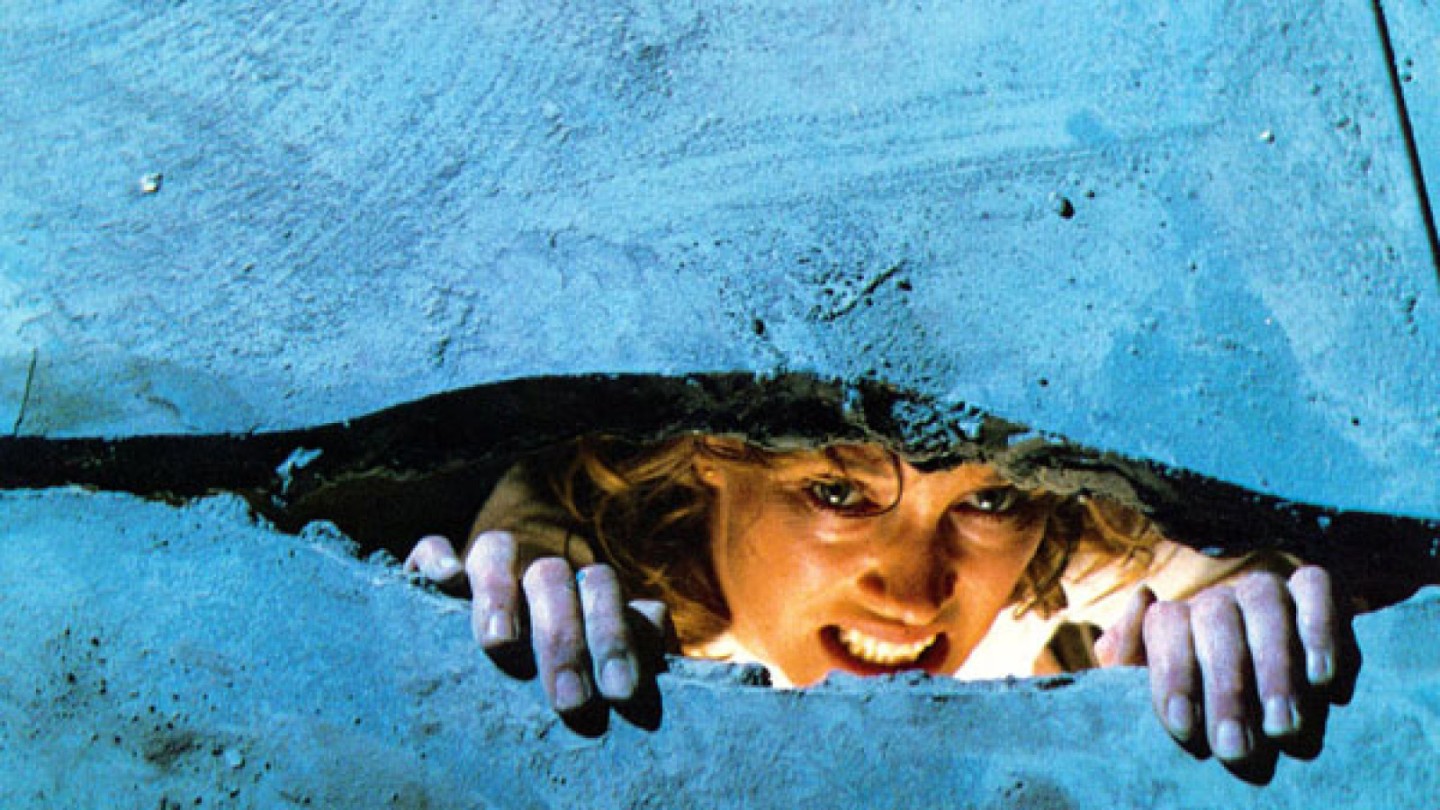
We have already mentioned the common theme of the trilogy at the beginning of this video. Then again, we missed a little detail about something that these movies have in common. They all end in despair, far from the kind of closure that the fans might expect. The climax is hopeless and the characters resign to their fate, which somehow uplifts the scary mood of the movies. There is yet another strange similarity! All three movies star Catriona MacColl, although in different roles that are completely unrelated.
The movies also share some similarities in their flaws. The narratives are often a bit jumbled, and sometimes logic simply goes out of the window. You might argue that you aren’t looking for logic in a gory horror flick, but things are stretched a bit too far for comfort at times. The acting performances too, are a bit lacking, especially from the supporting cast.
However, such issues aside, the trilogy highlights Lucio Fulci’s unique brand of splatter. The gore-hounds are in for an entertaining ride. His work might not be for everybody, but if you can digest the gross-out elements, you should go ahead and check out this trilogy!
